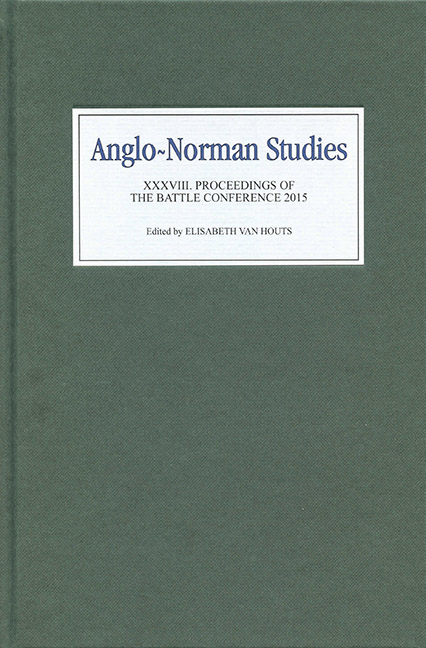Book contents
- Frontmatter
- Contents
- Illustrations and Tables
- Editor's Preface
- Abbreviations
- From the Articles of the Barons to Magna Carta (The R. Allen Brown Memorial Lecture, 2015)
- Jews in the Glosses of a Late Twelfth-Century Anglo-Norman Gratian Manuscript (Cambridge, Gonville and Caius College, MS 283/676)
- Monastic Autonomy, Episcopal Authority and the Norman Conquest: The Records of Barking Abbey (The Marjorie Chibnall Memorial Essay, 2015)
- Economy Distorted, Economy Restored: Order, Economy and Salvation in Anglo-Norman Monastic Writing
- Monastic Patronage and Family Disputes in Eleventh- and Early Twelfth-Century Normandy
- Constance, Princess of Antioch (1130–1164): Ancestry, Marriages and Family
- Early Aristocratic Seals: An Anglo-Norman Success Story
- English Towns and Urban Society after the Norman Conquest
- Wreck of the Sea in Law and Practice in Eleventh- and Twelfth-Century England
- Social Life and Religious Culture in Twelfth-Century Norwich and Norfolk
- Bad Crusaders? The Normans of Southern Italy and the Crusading Movement in the Twelfth Century
- Turold, Wadard and Vitalis: Why Are They on the Bayeux Tapestry?
Social Life and Religious Culture in Twelfth-Century Norwich and Norfolk
Published online by Cambridge University Press: 12 September 2017
- Frontmatter
- Contents
- Illustrations and Tables
- Editor's Preface
- Abbreviations
- From the Articles of the Barons to Magna Carta (The R. Allen Brown Memorial Lecture, 2015)
- Jews in the Glosses of a Late Twelfth-Century Anglo-Norman Gratian Manuscript (Cambridge, Gonville and Caius College, MS 283/676)
- Monastic Autonomy, Episcopal Authority and the Norman Conquest: The Records of Barking Abbey (The Marjorie Chibnall Memorial Essay, 2015)
- Economy Distorted, Economy Restored: Order, Economy and Salvation in Anglo-Norman Monastic Writing
- Monastic Patronage and Family Disputes in Eleventh- and Early Twelfth-Century Normandy
- Constance, Princess of Antioch (1130–1164): Ancestry, Marriages and Family
- Early Aristocratic Seals: An Anglo-Norman Success Story
- English Towns and Urban Society after the Norman Conquest
- Wreck of the Sea in Law and Practice in Eleventh- and Twelfth-Century England
- Social Life and Religious Culture in Twelfth-Century Norwich and Norfolk
- Bad Crusaders? The Normans of Southern Italy and the Crusading Movement in the Twelfth Century
- Turold, Wadard and Vitalis: Why Are They on the Bayeux Tapestry?
Summary
Most of the innovative attempts to explore in detail the religious lives of medieval lay people, particularly of people who enjoyed little fame or substance in their times, have addressed the period after 1300. Such efforts have been enabled by the documentation which created and regulated the parish – councils, canon law, episcopal registers and church-wardens accounts; by the engaging vernacular literature associated with pastoral care and private devotions; by new forms of organization created by lay people – particularly in towns and cities – for religious sociability, such as confraternities; and, more recently, by the use of liturgy and the material culture that underpinned it. Animating much of this historical work is an interest in women and gender, expressed in influential books like Caroline Bynum's study of religious women, many of them lay persons, in Holy Feast and Holy Fast.
This is not to say that religion has not received interesting treatments, or that religious life was duller in the Anglo-Norman period. Just a few years ago at the Battle conference, Hugh Thomas reflected on the sources and approaches that might best inform studies of the religion of the people between the Conquest and Lateran IV. He collected glimpses of parish life, of religious foundations, and even of guilds, in order to show that what we know of the later Middle Ages may well have existed earlier. What strikes me most forcefully about lay people's religion in that earlier period is the influence of religious houses, along with cathedrals – many of them also homes to monastic communities. Be it the cult of saints, hagiographical writing, the promotion of pilgrimage or even the support of parish life, monasteries were to the fore as producers of written works, custodians of holy relics, and magnets for religious enthusiasts both within and without their walls. Even those initiatives taken by lay people – like the creation of parishes in Lynn or Cambridge at the request of locals – had to be endorsed by them: in this case, Bishop Herbert de Losinga (d. 1119) or Barnwell priory respectively.
The Norman religious impetus energized – not without contestation and conflict – an English monastic sphere that was long-established, prestigious and wealthy.
- Type
- Chapter
- Information
- Anglo-Norman Studies XXXVIIIProceedings of the Battle Conference 2015, pp. 155 - 168Publisher: Boydell & BrewerPrint publication year: 2016



